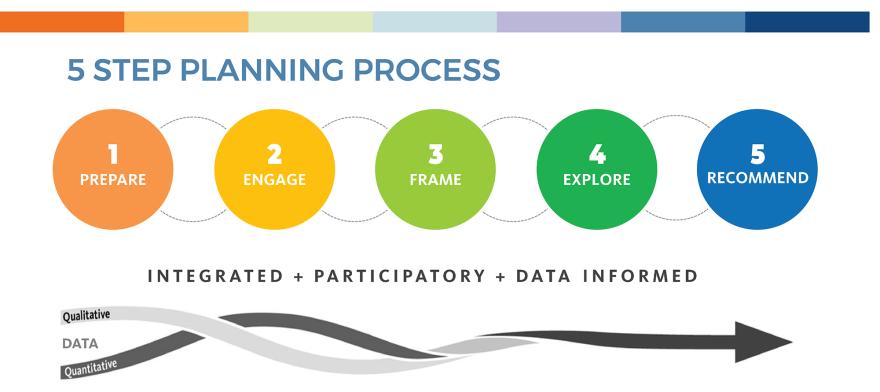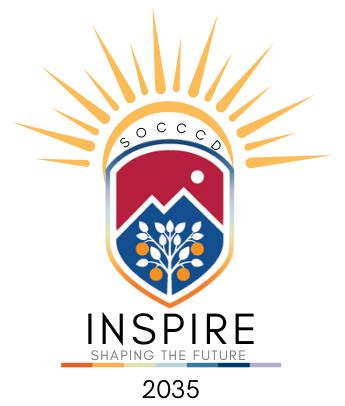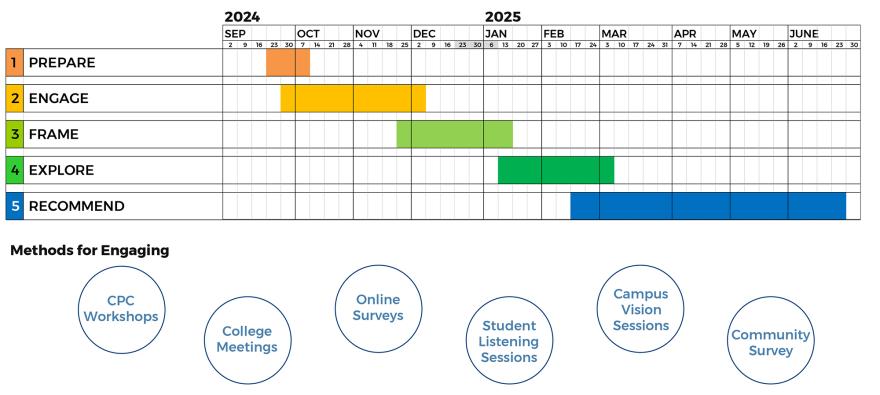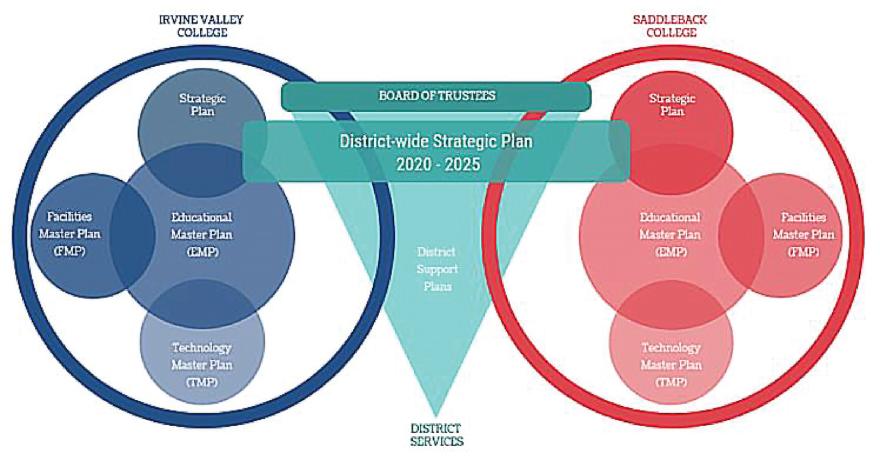Chancellor’s Message
As we embark on our strategic planning journey, I am excited to introduce, "Inspire 2035 - Shaping the Future", a long-range, comprehensive plan that will allow us to set a collective districtwide vision and direction for the South Orange County Community College District comprised of Saddleback College, Irvine Valley College, the Advanced Technology Education Park (ATEP), and District Services. This plan will serve as a critical roadmap for our district’s future, guiding our strategic priorities and facilities development to better serve our students, staff, faculty, and community.
Throughout this process, I am committed to inclusivity and transparency. All members of our community—students, faculty, staff, administrators, and local stakeholders— are invited to actively participate in shaping our strategic direction. Your insights and experiences are invaluable as we strive to build a vibrant educational environment that meets the diverse needs of our community. Together, we will shape the future of our district and colleges that prioritizes student success and equity, fosters community engagement, and promotes institutional excellence.
In the months ahead, we will be organizing a series of opportunities, such as visioning sessions, student listening sessions, surveys, and meetings to gather insights and feedback. And, you could always communicate directly with staff about the process or to share feedback anytime at communications@socccd.edu. I encourage you to actively participate in these opportunities to share your perspectives and ideas.
Thank you for your continued dedication and commitment to excellence. I am excited to join with you to shape the future of SOCCCD!
Updates
The Chancellor's Planning Council meets regularly to go over progress of the plan and check-in about engagement activities. Click the links below to view the presentations from recent workshops.
To communicate with staff directly about the planning process, please email: communications@socccd.edu
Planning Purpose
The strategic planning process for the South Orange County Community College District (SOCCCD) is designed to align our vision and mission with the dynamic needs of our students and the communities we serve. As part of the California community college system, we recognize our vital role in providing accessible, high-quality education that fosters personal, academic, and professional growth.
Key Purposes of Our Strategic Planning Process:
- Responding to Community Needs: The diverse populations we serve require tailored educational programs and services. Our strategic planning will enable us to assess and address these needs effectively, ensuring that our offerings remain relevant and impactful.
- Enhancing Student Success: At the heart of our mission is the commitment to student success. Through strategic planning, we will identify and implement initiatives that support student achievement, retention, and graduation, thereby equipping them for future challenges.
- Promoting Equity and Inclusion: We strive to create an inclusive environment where all students feel a sense of belonging and have access to educational opportunities. This process will help us identify barriers to success and develop strategies to foster equitable access and success.
- Reimagining our long-range Facilities Master Plan: We strive to ensure that our facilities meet current and future educational needs. Building upon our current Facilities Master Plan, this process will help to reestablish facilities guiding principles and reimagine our campus infrastructure to accommodate the ever-changing needs of our students in this new era.
- Building Community Partnerships: Collaborating with local organizations, businesses, and educational institutions is essential for creating pathways to success. Our strategic planning will focus on strengthening these partnerships to enhance resources, internship opportunities, and community engagement.
- Fostering Institutional Excellence: Continuous improvement is vital for our institution’s growth. The strategic planning process will help us assess our strengths and weaknesses, establish clear goals, and measure our progress, ensuring we maintain high standards of excellence in all areas.
- Adapting to Change: The landscape of education is constantly evolving, driven by technological advancements, workforce demands, and societal shifts. Through strategic planning, we will develop the agility needed to adapt to these changes and remain a leader in higher education.
By engaging in this comprehensive strategic planning process, we aim to create a clear, actionable roadmap that guides our efforts over the coming years. Together, we will shape the future of education in South Orange County, ensuring that our community colleges continue to meet the needs of our students and contribute to the broader goals of California’s higher education system.
The Planning Process
What is SOCCCD’s Inspire 2035 – The 5-Step planning process below is designed to be integrated, participatory, and data-informed.
Integrated – The planning process will be coordinated across the district to build a framework of linked Values, Mission, Vision, Long-term Goals, and Facilities Guiding Principals that unify and strengthen SOCCCD’s efforts to support students districtwide.
Participatory – This long-term, comprehensive plan will be developed in collaboration with the Chancellor’s Planning Commission and College Planning Teams. There will also be a variety of districtwide engagement opportunities to allow all voices to be heard.
Data Informed – The Inspire 2035 plan will integrate data gathered by a variety of research methods:
Qualitative
- Districtwide Survey
- Campus Visioning Sessions
- Community Listening Sessions and Surveys
- Observations
Quantitative
- Key Performance Indicators (KPI’s)
- Enrollment
- Retention and Success
- Persistence and Completion
- Employment
- Labor Market Trends
- Census Data
The purpose of the Chancellor’s Planning Commission (CPC) is to guide long term planning for the SOCCCD by way of developing the districtwide Strategic Plan 2035 and updating the Facilities Master Plan. The Commission is responsible for making recommendations to guide in the development of the Plans that align with the District’s vision, mission, and values. The Commission ensures that the planning process is inclusive, involving input from managers, faculty, classified professionals, students, and community members.
Chancellor's Planning Commission Members
The committee has a designated membership shown below and will invite additional content experts as resources to meetings related to the agenda items to be discussed (e.g., Economic Workforce Development (EWD), AI/Immersive Learning, DEIA, etc.).
Chair: Chancellor (1)
Co-chair: District Director, Research, Planning and Data Management (1)
33 Members of the Committee consist of:
- College Presidents, one from each college (2)
- Vice Chancellor, Business Services (1)
- Vice Chancellor, Human Resources and Employer/Employee Relations (1)
- Vice Chancellor, Technology & Learning Services (1)
- Vice Presidents for Instruction, one from each college (2)
- Vice Presidents for Student Services, one from each college (2)
- Vice Presidents for College Administrative Services, one from each college (2)
- Directors, Research, Planning, and Accreditation, one from each college (2)
- Directors of College Equity, Inclusion and Access, one from each college (2)
- Deans, one from each college, and one classified manager from District Services (3)
- Deans of Economic/Workforce Development, one from each college (2)
- Academic Senate Presidents, one from each college (2)
- Faculty representatives, two from each college as appointed by Academic Senates (4)
- Classified Senate representatives, one from each college and District Services (3)
- Representatives for Emerging Technologies (e.g. AI, Immersive Learning), one from each college (2)
- Student representatives, one from each college (2)
Timeline for Engagement
Reporting/Recommending Responsibilities:
Reports and recommends to the Chancellor.
Decision-Making Process:
The Commission uses consensus as the primary tool for making recommendations to the Chancellor. In the event that consensus cannot be reached, a majority vote will be used to establish a recommendation.
Communication Process:
SharePoint, two-way communication/feedback by committee representatives to constituent groups.
Oct. 11, 2024 CPC Workshop slide presentation





